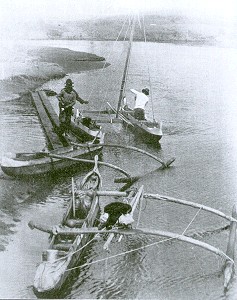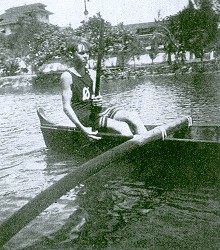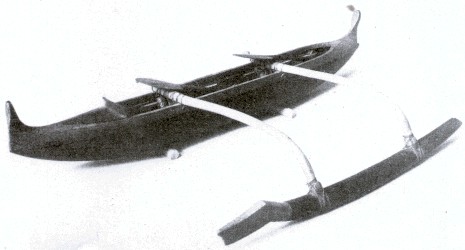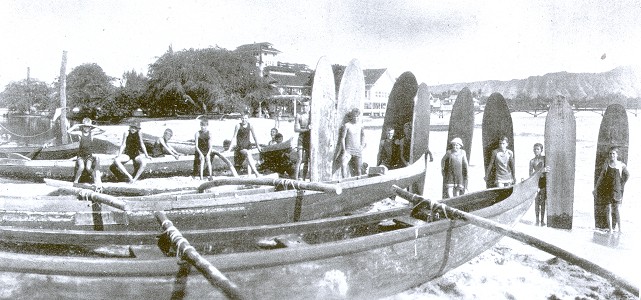 |
surfresearch.com.au
carter : building an outrigger canoe, 1912 |
| home | catalogue | history | references | appendix |
|
Several comments
and photographs are centred on the Outrigger Canoe Club, Waikiki.
See Source Documents:
1911 William
Contrell : The Hawaiian Outrigger
Canoe Club.
 |
|
 |
|
For a canvas canoe
it is best to secure a light log - the lighter the wood the better - about
six inches in diameter, with ends turned slightly upward.
If the canoe
is to be used for riding before the waves, the ama, or parallel stick,
should be far from the canoe; if for racing purposes, it should be drawn
closer.
In Hawaii the
iakus (the sticks connecting the awa with the canoe) are made from the
hau tree, and the down curve at the ama end is usually natural; however,
any kind of soft wood that can be bent easily will do.
The curved end
of the iaku is bound to the ama with heavy cord, the straight end to the
gunwales and thwarts of the canoe.
It is best to
have seats under the iaku and on these a block of wood about two inches
wide from one gunwale to the other, this block to be lashed by cords to
the seat and thwarts.
The iaku is then
lashed to this.
Augur holes are
bored ...
Page 440
 |
|
In launching,
the bow should pointed seaward and be kept so, for if the canoe broaches
to the waves and fills, she is liable to pound on the beach.
In landing, unless
the waves drop vertically to the strand, it is best to rush headlong before
a wave, which will usually leave the canoe high and dry on the beach, then
all that is necessary is to leap out, grasp the fore iaku near the canoe,
lift and drag the canoe above high water mark.
The guiding of
an outrigger canoe will be learned only through practice, the stroke that
would send an Indian canoe forward would cause the outrigger to describe
a circle.
Larger, wider
and stronger paddles are used and the harder the wood the better.
The helmsman
sits at the very stern and steers with his wide-bladed paddle parallel
to the canoe, pulling the handle toward him with a quick, even stroke,
or placing the blade in the water and pulling the stern of his craft toward
it.
To catch a wave,
he selects a long roller, gets before the uproll while it is forming and
paddles forward with all his might.
If he is to catch
the wave, the rising hill of water raises the stern of his canoe while
the bow points down to the hollow, and the mad onrush begins.
Once the wave
is fairly caught these (sic, there) is little danger of its rising
above the crest and sinking back - the skill now is to keep the canoe that
is pointing downward straight on her course.
If she swerves
to the outrigger side, the craft is apt to be raised sideways over the
crest ...
Page 442
... and the wave
lost, if to the off side, swamping is the penalty.
The rush of water
is so great that a paddle dipped sideways in the water is instantly torn
from the grasp and skill is needed in keeping the blade edge on.
The man in the
bow is usually deluged with a fountain that ascends over the prow, and
it is
his place to
rock the boat downward if there is danger of slipping back over the crest
of the wave. The man amidships must be prepared to run out on the outrigger
should it begin to lift from the water, or if it begins to submerge itself,
lean as far as he can in the opposite direction.
One man \vho
is skilful can handle a small outrigger canoe in a heavy surf, but two,
three or four are better numbers, it being safer for swimmers in the deeper
waters where the long rollers form.
At Waikiki Beach,
Honolulu, where a club of several hundred keeps outtrigger surfing sports
alive there is a run of a mile from the outer breaker to the beach.
The speed of
the canoe is forty miles an hour, and as the water is 76 the year round
the sport is indulged in at all seasons.
In fact the Outrigger
Canoe Club pulls off several events every year and some of the races are
often contested by as many as a dozen canoes that have canght the same
great roller and sweep at express speed toward the beach.
The Hawaiian
canoes are native mahogany dugonts to which the outriggers are bound, but
sometimes the canvas canoe is adapted for surfing.
To sail an outrigger
canoe, the craft is turned stem to bow, the iaku near the mast hole lengthened
on the off side by splicing or binding to it a bit of pole three or four
feet in length, to the end of which the halyards are made fast.
The steering
is done with the broad paddle, the sheet rope being help between the second
and big toe of the helmsman if there are but two occupants of the canoe.
The other man
is stationed, standing, at the mast, ready to run out on the outrigger
if a squall lifts it from the water or to lean in the other direction when
necessary.
Sailing races
usually start from the beach, the canoes all drawn up, two men to each,
on the strand; as the signal gun is fired, the canoes are launched, turned
around toward sea and away they go.
It is permissible
on the return, to catch, if possible, an incoming wave and coast before
it.
Often in this
...
Page 444
 |
|
... way the last becomes first and the first last.
There are thrills in surfing with the outrigger canoe unkown to the ordinary craft, and as all ordinary canoe may be turned into an "outrigger" without any particll!ar trouble or skill, the only requirement being a ball of twine, two young saplings and a log of wood, there is no reason why the sport should not be introduced on both our Atlantic and Pacific coasts.
Along the Southern
California coast and everywhere on the Atlautic seaboard there are places
where the outrigger canoe might become quite an addition to the water sports.
North of San
Francisco, on the Pacific, the waves are so gigantic and the water so cold,
that only skilled surfboatmen should make the attempt and even then large
boats should be used.
A youngng Hawaiian
did make the attempt off the Oregon coast, and with success, but a fatal
accident caused him to abandon the sport in such tremendous surf.
He had built
a special steel cylindrical ama, pointed at the ends, and his companion
in the canoe was warned not to jump out in case of an upset, on account
of the steel ama.
His companion,
however, unfortunately lost his head when a giant wave rose behind the
craft, leaped forward, was Struck by the pointed steel ama and killed.
No accidents
have ever been recorded anywhere when ordinarv cautions were observed.
While the Hawaiian
outrigger is the best and simplest in use on the Pacific, it may be well
to give a pattern of the general type of the South Sea Island outrigger,
with its several "iakus," the off ends of which rest in crutches crudely
built on the upside of the ama.
Perhaps the form
of outrigger canoe shown in one of the photographs will be easier for the
small boy to construct, and if he wishes to use his canoe for fishing purposes,
he may even build a platform a foot or two wide along the iakis, parallel
to and near the canoe.
On this he can
stow his nets, and if he wishes to build an awning above, may sprawl out
and sleep.
(Photograph,
page 445)
How
to Lift an Outrigger Canoe.
 |
Published by Alexander Hume Ford, Honolulu, Territory of Hawaii, Volume 3, Number 5, May,1912. |

| home | catalogue | history | references | appendix |